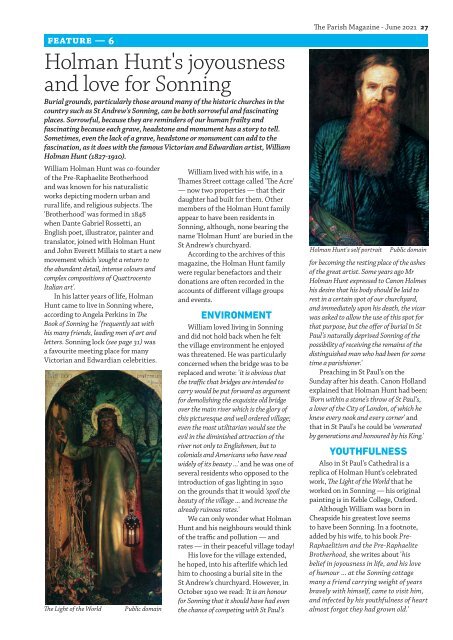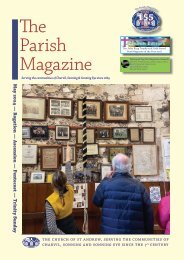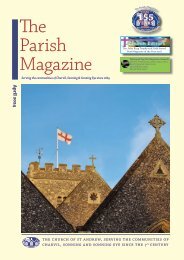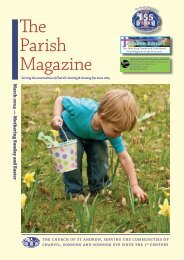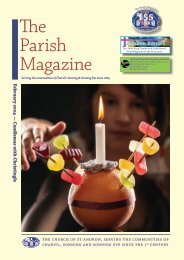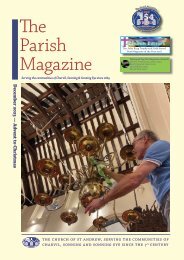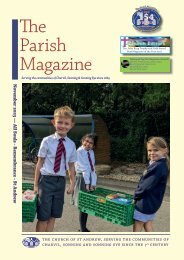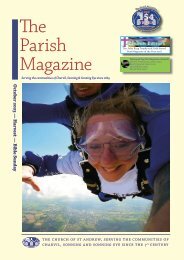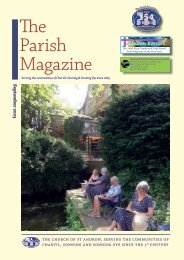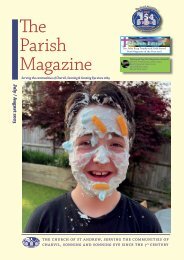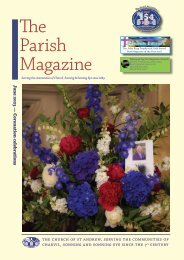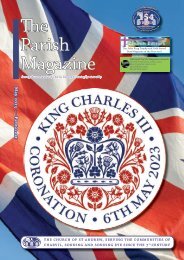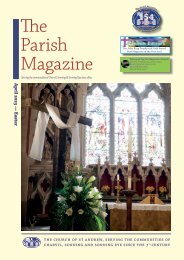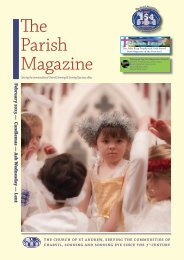The Parish Magazine June 2021
Serving the communities of Charvil, Sonning and Sonning Eye since 1869
Serving the communities of Charvil, Sonning and Sonning Eye since 1869
You also want an ePaper? Increase the reach of your titles
YUMPU automatically turns print PDFs into web optimized ePapers that Google loves.
feature — 6<br />
Holman Hunt's joyousness<br />
and love for Sonning<br />
Burial grounds, particularly those around many of the historic churches in the<br />
country such as St Andrew's Sonning, can be both sorrowful and fascinating<br />
places. Sorrowful, because they are reminders of our human frailty and<br />
fascinating because each grave, headstone and monument has a story to tell.<br />
Sometimes, even the lack of a grave, headstone or monument can add to the<br />
fascination, as it does with the famous Victorian and Edwardian artist, William<br />
Holman Hunt (1827-1910).<br />
William Holman Hunt was co-founder<br />
of the Pre-Raphaelite Brotherhood<br />
and was known for his naturalistic<br />
works depicting modern urban and<br />
rural life, and religious subjects. <strong>The</strong><br />
'Brotherhood' was formed in 1848<br />
when Dante Gabriel Rossetti, an<br />
English poet, illustrator, painter and<br />
translator, joined with Holman Hunt<br />
and John Everett Millais to start a new<br />
movement which 'sought a return to<br />
the abundant detail, intense colours and<br />
complex compositions of Quattrocento<br />
Italian art'.<br />
In his latter years of life, Holman<br />
Hunt came to live in Sonning where,<br />
according to Angela Perkins in <strong>The</strong><br />
Book of Sonning he 'frequently sat with<br />
his many friends, leading men of art and<br />
letters. Sonning lock (see page 31) was<br />
a favourite meeting place for many<br />
Victorian and Edwardian celebrities.<br />
<strong>The</strong> Light of the World<br />
Public domain<br />
William lived with his wife, in a<br />
Thames Street cottage called '<strong>The</strong> Acre'<br />
— now two properties — that their<br />
daughter had built for them. Other<br />
members of the Holman Hunt family<br />
appear to have been residents in<br />
Sonning, although, none bearing the<br />
name 'Holman Hunt' are buried in the<br />
St Andrew's churchyard.<br />
According to the archives of this<br />
magazine, the Holman Hunt family<br />
were regular benefactors and their<br />
donations are often recorded in the<br />
accounts of different village groups<br />
and events.<br />
ENVIRONMENT<br />
William loved living in Sonning<br />
and did not hold back when he felt<br />
the village environment he enjoyed<br />
was threatened. He was particularly<br />
concerned when the bridge was to be<br />
replaced and wrote: 'it is obvious that<br />
the traffic that bridges are intended to<br />
carry would be put forward as argument<br />
for demolishing the exquisite old bridge<br />
over the main river which is the glory of<br />
this picturesque and well ordered village;<br />
even the most utilitarian would see the<br />
evil in the diminished attraction of the<br />
river not only to Englishmen, but to<br />
colonials and Americans who have read<br />
widely of its beauty ...' and he was one of<br />
several residents who opposed to the<br />
introduction of gas lighting in 1910<br />
on the grounds that it would 'spoil the<br />
beauty of the village ... and increase the<br />
already ruinous rates.'<br />
We can only wonder what Holman<br />
Hunt and his neighbours would think<br />
of the traffic and pollution — and<br />
rates — in their peaceful village today!<br />
His love for the village extended,<br />
he hoped, into his afterlife which led<br />
him to choosing a burial site in the<br />
St Andrew's churchyard. However, in<br />
October 1910 we read: 'It is an honour<br />
for Sonning that it should have had even<br />
the chance of competing with St Paul’s<br />
<strong>The</strong> <strong>Parish</strong> <strong>Magazine</strong> - <strong>June</strong> <strong>2021</strong> 27<br />
Holman Hunt's self portrait<br />
for becoming the resting place of the ashes<br />
of the great artist. Some years ago Mr<br />
Holman Hunt expressed to Canon Holmes<br />
his desire that his body should be laid to<br />
rest in a certain spot of our churchyard,<br />
and immediately upon his death, the vicar<br />
was asked to allow the use of this spot for<br />
that purpose, but the offer of burial in St<br />
Paul’s naturally deprived Sonning of the<br />
possibility of receiving the remains of the<br />
distinguished man who had been for some<br />
time a parishioner.'<br />
Preaching in St Paul’s on the<br />
Sunday after his death. Canon Holland<br />
explained that Holman Hunt had been:<br />
'Born within a stone’s throw of St Paul’s,<br />
a lover of the City of London, of which he<br />
knew every nook and every corner' and<br />
that in St Paul's he could be 'venerated<br />
by generations and honoured by his King.'<br />
YOUTHFULNESS<br />
Public domain<br />
Also in St Paul's Cathedral is a<br />
replica of Holman Hunt's celebrated<br />
work, <strong>The</strong> Light of the World that he<br />
worked on in Sonning — his original<br />
painting is in Keble College, Oxford.<br />
Although William was born in<br />
Cheapside his greatest love seems<br />
to have been Sonning. In a footnote,<br />
added by his wife, to his book Pre-<br />
Raphaelitism and the Pre-Raphaelite<br />
Brotherhood, she writes about 'his<br />
belief in joyousness in life, and his love<br />
of humour ... at the Sonning cottage<br />
many a friend carrying weight of years<br />
bravely with himself, came to visit him,<br />
and infected by his youthfulness of heart<br />
almost forgot they had grown old.'


